by Elizabeth Cunningham
Mabel Dodge Luhan & Company: American Moderns and the West is currently in Mabel’s hometown. The exhibition, hosted by the Burchfield Penney Art Center at SUNY Buffalo State in Buffalo, New York, runs March 10 through May 28, 2017.

STORY OF AN EXHIBITION: Mabel Dodge Luhan & Company tells the story of this extraordinary woman and the remarkable people from Buffalo to Europe and New York to New Mexico whose lives—and artistic creations—intersected with hers. Living in Taos from 1918 until her death in 1962, Mabel influenced legions of European and American “movers and shakers” to find in northern New Mexico’s physical and cultural landscapes new aesthetic, social, and cultural perspectives on modern life. Her “artist residency” support not only brought modern art to northern New Mexico, it put Taos on the national and international maps of the avant-garde and created a “Paris West” in the American Southwest.
This exhibition is the first to explore the impact Mabel Dodge Luhan had on some of the most compelling modern American artists, writers, and social activists. These include writers D. H. Lawrence and Willa Cather, painters John Marin and Georgia O’Keeffe, photographers Paul Strand and Ansel Adams as well as choreographer and dancer Martha Graham, composer Leopold Stokowski, and social reformer John Collier. Mabel’s role as arts patron and social advocate runs parallel. The show also offers “a glimpse at the uproarious, complicated life of a woman whose goal was to revolt against the old-fashioned, Victorian environment in which she was raised.”
Thirty years in the making, the exhibition was co-curated by MaLin Wilson-Powell, an independent art critic, lecturer, curator, editor, and educator; and Dr. Lois Rudnick, the author and preeminent scholar on Mabel Dodge Luhan, with eight books published on Luhan and her circle. The exhibition premiered at the Harwood Museum of Art of the University of New Mexico in Taos (May-September 2016), then traveled to the Albuquerque Museum (October 2016-January 2017).
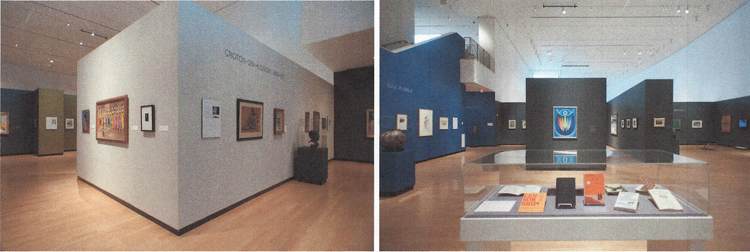
Mabel & Company Installation sections L: Croton-on-Hudson; R: Taos and modernism
FINAL STOP, BUFFALO: The Burchfield Penney Art Center’s mission to represent the art and culture of Western New York intersected with the goals of Mabel & Company exhibition.
For this presentation, Charles Cary Rumsey Curator Nancy Weekly added art, artifacts and memorabilia amplifying Mabel’s ties to Buffalo.
Asked about her vision for the Burchfield Penney show, Nancy provided an overview:
Our museum has wanted to bring attention to this extraordinary, complex woman for decades. In a world dominated by men, Mabel used her wealth to help the disenfranchised have the time, space, and means to promote their ideas and create new work. She challenged 19th-century societal values in so many ways.
Nancy also spoke to the Art Center’s broader goals for Mabel & Company:
The exhibition concentrates on visual arts produced by people she inspired in Buffalo, Italy, New York City, Croton-on-Hudson, and Taos; but she also provided safe haven for social and political activists to state their views to instigate real change in issues such as women’s suffrage, birth control, and labor rights.
We hope this exhibition will be the impetus for people to learn through art about society’s struggles during Mabel Dodge Luhan’s lifetime, and be inspired to engage today as change-agents for the 21st century.
EXHIBITION INSTALLATION
Set up in several sections, Mabel Dodge Luhan & Company utilizes the trajectory of Mabel’s life to depict her evolution from the Victorian era to American modernism. The exhibition’s 160 paintings, photos and sculpture provide a parallel evolution in American art. This narrative arc contains the art and ephemera that Mabel inspired in her circle of artists, writers, composers, and dancers. Many who attended her New York salon (1912-1915) later became her guests in Taos. The luminaries Mabel hosted at her complex found inspiration in the landscape and cultures of northern New Mexico. Their creative output—books, music, dance, art—is a snapshot in time. Their collective work captures the landscape and cultures of Taos from 1918 to 1947.
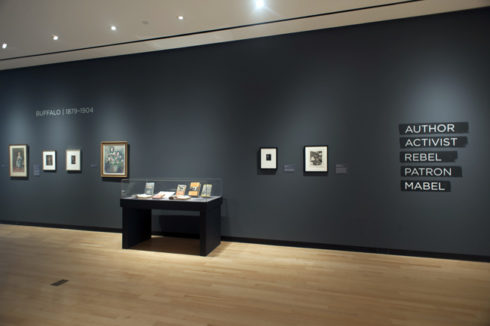
Burchfield Penney’s Senior Preparator Patrick Robideau used different wall colors to delineate the exhibition’s various sections. In designing the installation in Buffalo, Nancy condensed the exhibition’s theme to its essentials. Lettering at the entrance declares: Author / Activist / Rebel / Patron / Mabel.
The section “Buffalo, 1879-1904” addresses Mabel’s formative years. Born in Buffalo on February 26, 1879, Mabel Ganson led a rebellious life, eager to break from conservative society in what at the time was one of the largest and most important cities in the United States. The Gansons lived on “Millionaire’s Row” at 675 Delaware Avenue. Mabel called it “a home destined for sorrow.” Like others of the Victorian wealthy elite, her parents left childrearing duties to governesses and nursemaids. Isolation, the fall-out from her parents unhappy, turbulent marriage, and their lack of affection left a lasting mark on Mabel. Yet, she dedicated Background, the first volume of her memoirs, to Buffalo. In her book Mabel depicts both the darkness and the light that she and her milieu experienced and endured. “I would not have had it different…I like my Buffalo as I knew it.”
NEW CONNECTIONS
“Mabel’s Legacy in Buffalo” sparked my curiosity. Besides her memoir on Buffalo, what kind of legacy did Mabel leave her home town? Three individuals featured in the Burchfield installation best demonstrate this. Their names? Rose Clark, Nina Wilcox Bull, and Martha Visser’t Hooft.
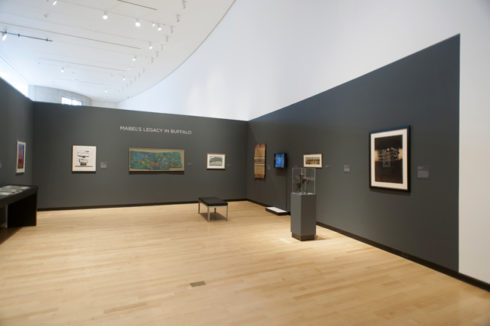
“Mabel’s Legacy in Buffalo” section, Martha Visser’t Hooft wall at back of room
As recognized artists of Western New York, Rose Clark and Martha Visser’t Hooft also received national renown through exhibitions in institutions as prestigious as the Metropolitan Museum of Art and the Whitney Museum of American Art. Among other museums, the Burchfield Penney and the Albright-Knox collected their work. Nina Wilcox Bull advocated New Thought and Progressive schools. In later life, she pioneered the study of the mind/body relationship. Her scientific career contributed to what is now known as somatic psychology.
Photos and art by these women lent substance to their names. What was their connection to Mabel? I delved into her memoirs. I researched archives and conducted interviews. My efforts resulted in two realizations. Mabel provided these women with time and space for their creative endeavors. The friendships that began in Buffalo lasted throughout their lives.
# # # # #
Rose Clark (1852-1942)
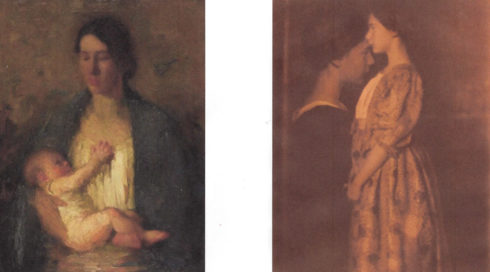
Rose Clark L: Untitled (painting) R: Double Exposure ca. 1898 (photo). Courtesy Burchfield Penney Art Center
Mabel attended art classes taught by Rose Clark at St. Margaret’s School. On Saturdays outside of school, Mabel occasionally visited her teacher’s studio. Under Rose Clark’s tutelage, she developed both an aesthetic sensibility and an appreciation of art. When Mabel made her debut into society, she enlisted her mentor’s help. Rose Clark’s artistry and design sense helped transform the Twentieth Century Club’s characterless ballroom into a Baronial Hall. Banners and coats of arms hung next to great family portraits in the style of Rembrandt and Velásquez.
After Mabel and her second husband, Edwin Dodge, bought the Medici Villa Curonia near Florence, Italy in 1905, Mabel invited “Tante Rose” to help her decorate it. Rose stayed on for several months, helping Mabel manage the household. Rose immersed herself in Italy’s art and architecture. She also pursued her painting there, often using Mabel’s son John Evans as a model. Around 1914 Mabel invited Rose to stay in Croton-on-Hudson. She watched over Finney Farm while Mabel was resident in New York City.
Known in the 1890s as a painter, Rose later became one of the Buffalo Camera Club’s most successful photographers. Alfred Stieglitz praised and exhibited her pioneering work. In 1902 he included her in his landmark American Pictorial Photographers portfolio. That same year in Stieglitz’s Century Magazine article, he counted her one of the ten best contemporary photographers. From 1898 to 1910 Rose collaborated with author, poet and photographer Elizabeth Flint Wade. Their work was exhibited internationally in Glasgow, Paris, The Hague, and Vienna. One of their photos garnered a gold medal at the exhibition in Turin, where Stieglitz selected photography for the American section. Rose exhibited her own work separately from 1899 to 1915. Reviewing her work in the 1904 Pittsburgh show, a critic wrote:“The most successful portrait work (next to Steichen’s, of course) is furnished by Miss Rose Clark. She must be a close student of painting, all her work, without losing its individuality, is reminiscent of good examples of pictorial art.”
# # # # #
Nina Wilcox Bull (1880-1968)
I liked playing with Nina because I could make her do as I liked…She was always obedient. – Mabel Dodge Luhan
Cornelia “Nina” Wilcox was the daughter of Ansley and Cornelia Rumsey Wilcox, whose home became the inauguration site for Theodore Roosevelt in 1901 after President McKinley was assassinated. Nina married Henry Adsit Bull in 1901. The couple divorced in 1916.

L. Panoramic sketch of Delaware Avenue, ca. 1873. Courtesy Buffalo Architecture and History; Ansley Wilcox Mansion, 641 Delaware Avenue, present Theodore Roosevelt Inaugural Site. Courtesy Theodore Roosevelt Inaugural Site
Mabel’s first playmate and close childhood friend, Nina lived two mansions away on Delaware Avenue. The two ran back and forth between houses. They climbed trees and munched grapes in the Wilcox’s backyard. They played tag and hide and seek with Nina’s Rumsey cousins. Exploits invented by Mabel often landed them on the cross side of Nina’s stepmother and other parents.
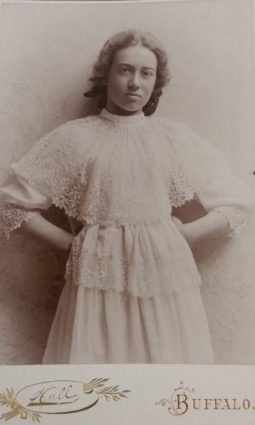
Nina Wilcox, 1893. Photo by Eleck F. Hall. Collection of the Theodore Roosevelt Inaugural Site Foundation. Courtesy Burchfield Penney Art Center
Time spent at Mabel’s Greenwich Village salon (1912-1915) exposed Nina to current modernist trends. One night she joined her friend for dinner with Margaret Sanger. In Mabel’s sitting room the founder of the nation’s first birth control clinic related the mysteries of “sex expression.” Through her relationship with Leo Stein in Paris [another Mabel connection], Nina was already aware of European modernists like Picasso and Matisse. In New York, she encountered the American avant garde shown at Alfred Stieglitz’s Gallery 291. After viewing Marsden Hartley’s paintings, Nina hosted an exhibition of his work at 80 Rumsey Road, the Bull’s home in Buffalo. Comings and goings continued outside New York. When Mabel lived in Provincetown, Nina took a house across the Hudson in Nyack.
Around 1920 Nina visited Mabel in Taos. By then Mabel knew many locals, including the slim, capable sheriff and sawmill owner Lee Witt. She appreciated his knowledge of folk songs and the early history of Taos. His twinkling blue eyes and fine singing voice evidently captivated Nina. The two were married in 1921. The couple socialized with locals and with Mabel’s guests, including D. H. and Frieda Lawrence. When the Witt’s marriage ended in divorce in 1923, Nina departed Taos.
Nina Wilcox Bull became known for her achievements in education and in psychology. Her father Ansley Wilcox had set precedents. He abandoned a successful law career for philanthropic pursuits. Among other charities, he founded the first day center for working mothers in the United States. In 1911 Nina enlisted psychologist and educational reformer John Dewey to help establish a school in Buffalo. (Founded a year later, and distinguished as one of the oldest Progressive schools in the country, The Park School is still in existence.) Nina shared her ideas on education. In 1918 her op-ed “New Ideas in Teaching’ appeared in the New York Times.
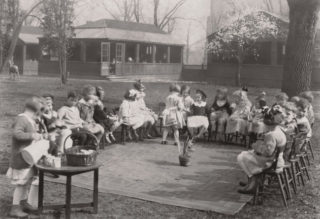
First graders enjoy outdoor dining room at the original Park School on Bird Avenue, circa 1917. Courtesy The Park School
While in her mid-fifties Nina Bull focused her scientific career on somatic psychotherapy. Her first publication, The Attitude Theory of Emotion (1951), preceded three more leading-edge volumes on the body-mind connection. This interest grew out early 20th-century spiritualism. After studies with New Thought advocate and founder Emma Curtis Hopkins, Nina became a Divine Science practitioner in New York. She treated Mabel for a brief period in 1915.
# # # # #
Martha Hamlin Visser’t Hooft (1906-1994)
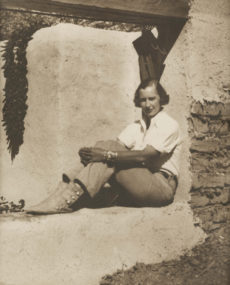
Martha Visser’t Hooft in Taos, 1932. Photo by Franciscus Martha Visser’t Hooft. Courtesy Burchfield Penney Art Center
The story of Martha Hamlin Visser’t Hooft begins with her parents, Chauncey Jerome Hamlin and his wife, Emily Gray Hamlin. Good friends of Mabel’s from Buffalo, the couple had similar cultural interests. Chauncey served as president of the Buffalo Society of Natural Sciences (a major force behind building the Buffalo Museum of Science). Later as president of the American Association of Museums, he also created the International Council of Museums. A social activist interested in the arts and philosophy, Emily was the first president of the Buffalo Chamber Music Society.
In 1928, the Hamlins took their daughters Mary and Martha on a trip to Taos to visit Mabel Dodge Luhan and her husband Tony Lujan. Tony led the visitors on horseback to Blue Lake, a sacred Taos Pueblo site.
Shortly after the family’s return to Buffalo, Martha Hamlin married Franciscus Visser’t Hooft, a Dutch chemist. She continued her pursuit of art while raising a family of three children. Her sister Mary vowed to return to Taos. Initially she stayed at Mabel’s and connected with her circle of friends. British painter Dorothy Brett chaperoned Mary and the Russian artist Nicolai Fechin painted her portrait. Months later Mary bought a house in Talpa, 3 miles southeast of Taos.

Martha Visser’t Hooft. New Mexico Mesa, c. 1950s Gouache on paper, 7-1/2 x 23-1/8 in. Collection of Martje More. Courtesy Burchfield Penney Art Center
In the 1930s Martha visited Mary several times. Reacquainted with Mabel and Tony, she met Brett, Frieda Lawrence, writer Frank Waters, and poet and journalist Spud Johnson. Memories of raucous parties with these luminaries stayed with Martha. So did the landscapes of northern New Mexico.
Eschewing a traditional college education, Martha chose an art career. In the 1920s she studied at the Académie Julian, a private art school in Paris. While there, Martha explored cubism and surrealism, modern Russian ballet, avant garde theater, and modern music. Her paintings would later reflect her European experiences. To champion modernism, Martha helped found Buffalo’s Patteran Society, an alternative to the more traditional Buffalo Society of Artists, in 1933. By the time she exhibited at New York’s Contemporary Art Gallery in the 1940s and 1950s, the influence of abstract expressionism appeared in her work.

Martha Visser’t Hooft L: Blue Shards, 1969; R: Wounded Knee, n.d. Courtesy Burchfield Penney Art Center
Beginning in the 1960s, Martha’s paintings grew increasingly abstract. In 1973 the Burchfield Penney produced a major retrospective honoring Martha Hamlin Visser’t Hooft. As seen in the Mabel & Company exhibition, the geography of the American Southwest also inspired her.
# # # # #
Acknowledgments. A hearty thank you to the following individuals: Burchfield Penney Art Center staff members Nancy Weekly, Burchfield Scholar, Head of Collections, and Charles Cary Rumsey Curator for text and object photos, Additional photos provided by Kathleen M. Heyworth, Director of Marketing and Public Relations, for Mabel & Company installation photos. Additional photos: Stanton H. Hudson, Jr., Site Superintendent and Executive Director, Theodore Roosevelt Inaugural Site; to Carolyn Hoyt Stevens, Director of Development, The Park School; Chuck LaChiusa, tour guide, speaker, and creator of the Buffalo Architecture and History website. Special appreciation to Hamlin family descendants Martje More for information on Martha Hamlin Visser’t Hooft and Nancy G. Lopez for information on Mary Hamlin Goodwin. Finally, to Dr. Lois P. Rudnick for her invaluable eight books on Mabel Dodge Luhan.